Fast Facts
- When: 8th August 2023 to 25th February 2024
- Where: Various, Final at Wembley Stadium, London
- Watch: Sky Sports
- Official Website: Carabao Cup
The English Football League Cup is one of the three major domestic trophies in English football, alongside the Premier League and FA Cup. Although the League Cup is considered the least prestigious of the three honours, it is still a prize well worth winning and is the first opportunity for teams to secure major silverware in the season.
All 92 of England’s football league clubs enter the tournament, which involves a one leg knockout format until the semi-finals which are normally contested over two legs. The final is played at Wembley Stadium in either late February or early March.
Below you can find further information of the history of the competition, as well as the latest betting offers when they become available.
Existing Customer Free Bets & Money Back Offers
Please Note: This event has now ended.
Stats Articles
Event Stats
Last 10 EFL Cup Finals – 2015 to 2024
| Date | Winner | Score | Runner-Up |
|---|---|---|---|
| 25th Feb 2024 | Liverpool | 1-0 AET | Chelsea |
| 26th Feb 2023 | Manchester United | 2-0 | Newcastle United |
| 27th Feb 2022 | Liverpool | 0-0 AET, 11-10 pens | Chelsea |
| 25th Apr 2021 | Manchester City | 1-0 | Tottenham Hotspur |
| 1st Mar 2020 | Manchester City | 2-1 | Aston Villa |
| 24th Feb 2019 | Manchester City | 0-0 AET, 4-3 pens | Chelsea |
| 25th Feb 2018 | Manchester City | 3-0 | Arsenal |
| 26th Feb 2017 | Manchester United | 3-2 | Southampton |
| 28th Feb 2016 | Manchester City | 1-1 AET, 3-1 pens | Liverpool |
| 1st Mar 2015 | Chelsea | 2-0 | Tottenham Hotspur |
Schedule
- First round: Tuesday 8th & Wednesday 9th August 2023
- Second round: Tuesday 29th & Wednesday 30th August 2023
- Third round: Tuesday 26th to Wednesday 27th September 2023
- Fourth round: Tuesday 31st October Wednesday 1st November 2023
- Quarter-finals: Tuesday 19th & Wednesday 20th December 2023
- Semi-final 1st Legs: Tuesday 9th & Wednesday 10th January 2024
- Semi-final 2nd Legs: Tuesday 23rd & Wednesday 24th January 2024
- Final: Sunday 25th February 2024, kick-off 15:00
This schedule subject to confirmation and may change.
About The EFL Cup
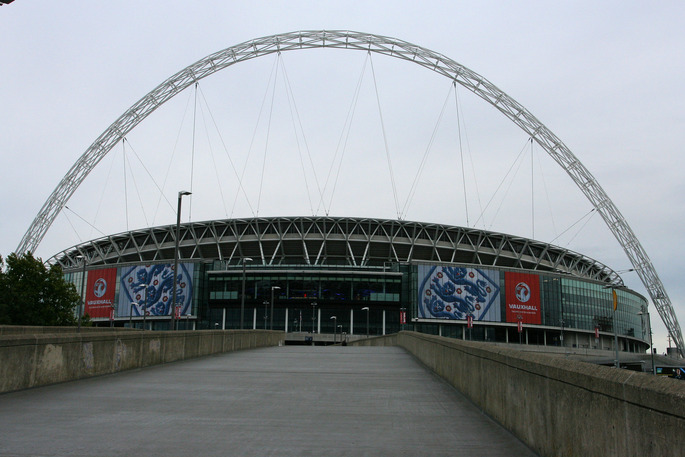
The League Cup has an odd place in the history of English football. The FA Cup is the oldest cup competition in the world, thereby earning itself a degree of respect from all corners of the game. The League Cup, on the other hand, was first held nearly one hundred years after its more illustrious counterpart and has endured almost as many name changed as it has winners.
Despite what the competition’s organisers might have you believe, few top clubs take the League Cup serious as a competition in the early stages. It’s common for managers to rotate their teams for games in the tournament, often sending out their perceived ‘weaker’ sides in order to protect their first eleven for matches that are seen as more important. Organised by the English Football League since its formation in 1960, the competition is officially known as the EFL Cup.
Part of the reason for the tournament’s lack of prestige amongst the top clubs comes in the form of its prize money. Winners get £100,000 and runners-up receive £50,000, which is in stark contrast to the £2 million in prize money handed out to the winning team in the FA Cup.
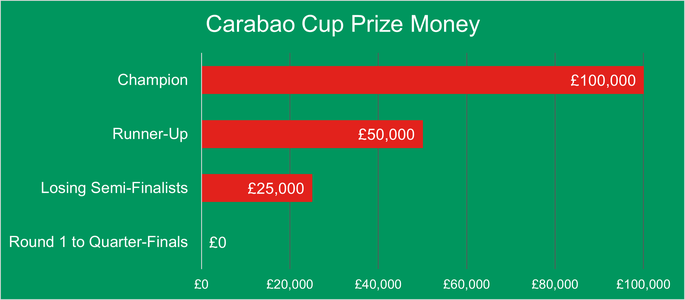
The League Cup Trophy
The League Cup has undergone three different designs over the years. The original trophy was actually paid for by the President of the Football League, Joe Richards. He was so proud of the competition that he’d helped to create that he has his own name put on the trophy. That remained the silverware until the 1981-1982 season, at which point the Milk Marketing Board felt that they could further their own cause by offering a cup that they designed. When Littlewoods took over sponsorship duties in 1986 they also awarded their own trophy, with the original not returning into circulation until 1991.
That originally trophy has been used ever since and was designed and manufactured by the silversmith Mappin & Webb. It is a Georgian-style urn that boasts three handles and is worth around £20,000. Weighing just shy of three kilograms and measuring twenty-seven centimetres by twenty point five centimetres, it has a separate plinth.
Format & Rounds
The EFL Cup, which will be referred to interchangeably by that title and its more colloquial one of the League Cup throughout this article, is played over a total of seven rounds. Teams enter the competition according to their place in the English Football League system, resulting in the top sides getting a bye to later stages initially. That was seen as the easiest way to ensure that the competition didn’t cause too many problems in terms of fixture congestion, given that all ninety-two members of the Football League and the Premier League are invited to take part in the tournament.
The competition is deliberately organised so that just thirty-two teams are left in it by the time that the third round gets underway. Premier League teams are given a bye to the second round, with the exception of any clubs involved in European tournaments that get a bye to the third round. Also given a bye to the second round are the two teams that finished 18th and 19th in the previous season’s Premier League campaign, essentially the two better performing relegated sides.
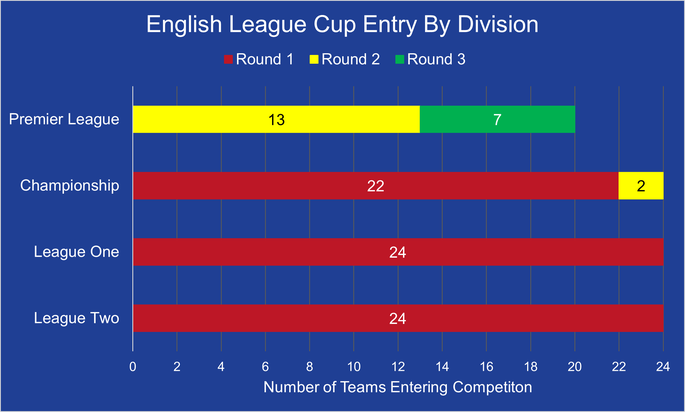
To add a degree of confusion to the matter, it is possible for the number of byes being given to teams to result in an odd number of sides heading into one of the rounds. When that happens, there are a number of things that can be done to level things out. Usually the highest placed side that was relegated from the top-flight the season before, but it’s also sometimes necessary for preliminary round to be played between the two teams that gained promotion for the Football Conference into the Football League the season before. If only one team gains promotion then they’ll play the lowest Football League team that didn’t get relegated.
Each round of the League Cup is played over one leg, with the only exception to this normally being the semi-final stage that has two legs. The draw determines which team’s ground the match is played on for the first five rounds, with the semi-final having a leg played at each ground with the first home side dictated by the draw. The final is played at Wembley and is the only round to take place at a neutral venue.
Since the 2018-2019 incarnation of the League Cup, extra-time is only played in the final. If any of the earlier rounds are still level after ninety minutes then the match will go straight to penalties to decide the outcome.
Changes over the Years
As you might expect for a competition that’s been running for as long as the League Cup has there have been a number of changes to the above format over the years. The first thing worth mentioning is that to begin with the Cup had a final that was based over two legs, only changing to one leg in 1967. The first round became two-legged in 1975 and remained so until 2000, which is also the year that the second round became one-legged having had two legs since 1979.
Perhaps one of the biggest reasons that the League Cup was thought to be something of a drain on resources for clubs is the fact that single-legged rounds had to be decided by replay prior to the 1993-1994 season. That resulted in a large number of games seeing one, two or even three replays being required in order to find a winner. That only stopped when penalties were brought in as a deciding factor at the end of the first replay. That necessity to replay games also applied to two-legged times until the 1974-1975 campaign, meaning that sides who couldn’t be separated after extra-time in the second-leg went to a replay. They continued to be replayed until 1980, only a penalty shoot-out was used at the end of the replay.
When the competition was played in the 1980-1981 season the away goals rule and a penalty shoot-out was introduced for two-legged ties. The only round that this wasn’t the case for was the semi-final stage, which still went to a replay until 1986. There were plans to remove the UEFA Cup place from the League Cup when it became the Europa League at the start of the twentieth century, but these were abandoned when the Football League realised how popular the competition was with supporters of teams who were unlikely to get into Europe any other way.
A Myriad Of Name Changes
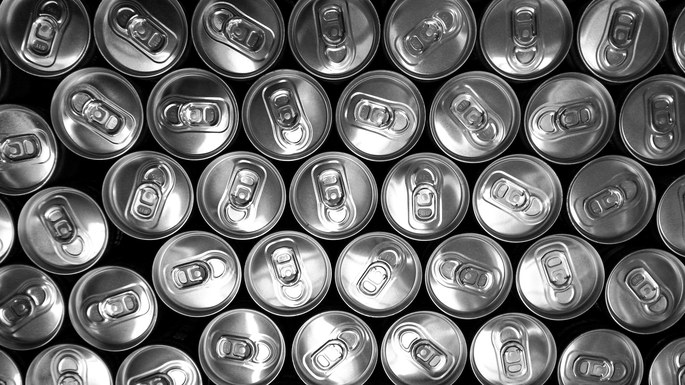
As well as a number of format changes, the League Cup has also undergone a large amount of name changes over the years. The majority of these have come about because of sponsorship, such as the switch to become the Milk Cup when the Milk Board got involved in 1981. That lasted up until 1986 when Littlewoods began sponsoring the trophy and it became the Littlewoods Challenge Cup for four years.
In 1990 that switched to Rumbelows, with the Rumbelows Cup played for until Coca-Cola took on the sponsorship duties between 1993 and 1998. After Coca-Cola came Worthingtons and the need to refer to it as the Worthington Cup until 2003.
In 2003 the competition found its longest-running sponsor since the Milk Board when Carling began sponsoring it and it became known as the Carling Cup until 2012. From 2012 until 2016 the participating teams had to refer to as the Capital One Cup after sponsorship started coming from the financial company Capital One.
The Energy drinks company Carabao began its sponsorship duties in 2017, meaning that it became the Carabao Cup. Having been known as the Football League Cup since its formation in 1960, the trophy officially became the EFL Cup in 2016 when the Football League was re-branded as the English Football League and the trophy changed names in order to maintain a degree of continuity between the two.
| Name | Year From | Year To |
|---|---|---|
| Carabao Cup | 2017/18 | Present |
| EFL Cup | 2016/17 | 2016/17 |
| Capital One Cup | 2012/13 | 2015/16 |
| Carling Cup | 2003/04 | 2011/12 |
| Worthington Cup | 1998/99 | 2002/03 |
| Coca-Cola Cup | 1992/93 | 1997/98 |
| Rumbelows | 1990/91 | 1991/92 |
| Littlewoods | 1986/87 | 1989/90 |
| Milk Cup | 1981/82 | 1985/86 |
| Football League Cup | 1960/61 | 1980/81 |
The Early History of the League Cup

Stanley Rous, who was the Secretary of the Football Association between 1934 and 1962 and would later go on to be the President of FIFA, envisaged a League Cup as something of a consolation prize for teams that were knocked out of the FA Cup early on. That never quite came to pass, but the idea of having another cup in addition to the more prestigious one never quite went away and the competition was eventually implemented by the Football League Secretary Alan Hardaker.
Part of Hardaker’s plan was based around the idea that the Football League was planning a major re-structuring of the way it worked, which would have seen football clubs lose revenue when matches weren’t played during this re-structuring phase. Playing a cup competition would ensure that no revenue was lost in terms of gate receipts, so the Football League gave it its go-ahead prior to the 1960-1961 campaign. The Football League was hoping that a new cup competition might cause a resurgence in interest from supporters, with attendance having seen a bit of a drop off in the seasons prior to the cup’s launch.
There was another reason that the League Cup caught the imagination of the participating football clubs other than just their own financial benefit; in the 1950s floodlights had begun to be installed across a number of stadiums, so it was hoped that the new competition could be similar to the Southern Professional Floodlit Cup that had been introduced at night under the floodlights. The combination of the interest of the clubs that would play in the tournament and the desire of the Football League for attendances to grow after a drop-off in the region of one million people meant that nobody called for the EFL Cup to be abandoned when the league’s restructuring never actually took place.
Tension with The FA & Competition from Europe
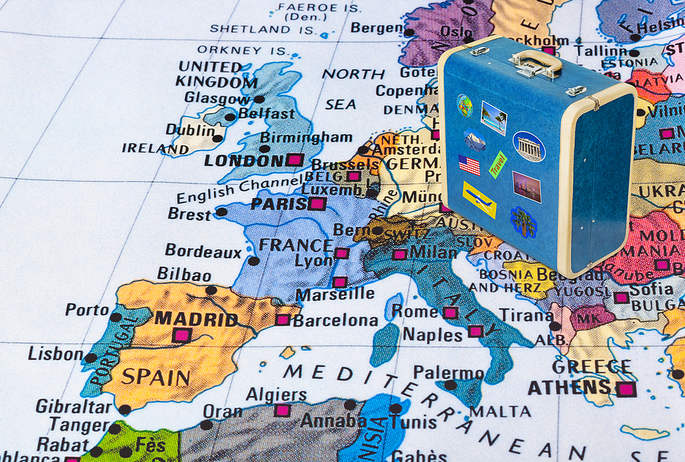
The English Football League Cup came into being at just the right time as far as the Football League was concerned, given that they’d been enduring some issues with the Football Association over the manner in which revenue was shared by clubs. It meant that the very notion of the competition was sneered at by some before it had even begun; a feeling that wasn’t helped by the fact that the European Cup had been created five years before and it was feared that the bigger clubs in the First Division might want to join a European League instead of extra domestic football.
The ‘continental fever’ that was sweeping the English top-flight didn’t go unnoticed by Joe Richards, the President of the Football League. When the very idea of establishing a League Cup had gone to the Football League clubs for a vote, it had only narrowly passed by a vote of 31-16. There was concern amongst the top brass that the newly minted tournament might not gain the respect of the biggest sides, but those fears were allayed when the inaugural outing of it saw the club considered to be the most successful in the country at the time, Aston Villa, lift the trophy.
A Change In Mentality Of The Top Clubs
If the Football League had believed that Aston Villa’s win in the competition would automatically mean that it would gain respect from all sides then there were soon disabused of that notion. The next three winners were all sides that had never won major silverware before, with the victory of Norwich City despite not having even played in the top-flight before being an insult to the competition in the eyes of many. It started to gain a little bit more respect when Hardaker had informed UEFA that Football League teams wouldn’t play in the UEFA Cup unless a place in it was reserved for the winner of the EFL Cup. UEFA agreed, although they did add the rule that the winning side needed to be in the top-flight in order to take up the slot.
Another shifting moment in terms of how the trophy was seen occurred in 1967 when the final was moved to Wembley for the first time. Suddenly it started to have some genuine appeal for teams who would not only get to play at the national stadium if they reached the final but would also earn themselves a place in a European competition, meaning that they could make up for a disappointing league campaign if they did well in the cup. Manchester United and Everton both decided not to enter teams to play in it, with the Merseyside club opting to sit-out the tournament in the 1970-1971 outing of it because they were in the European Cup and believed that required their full attention. The Football League responded by saying that all teams under their command must enter the League Cup from the 1971-1972 season onwards.
Liverpool’s Domination in the 1980’s
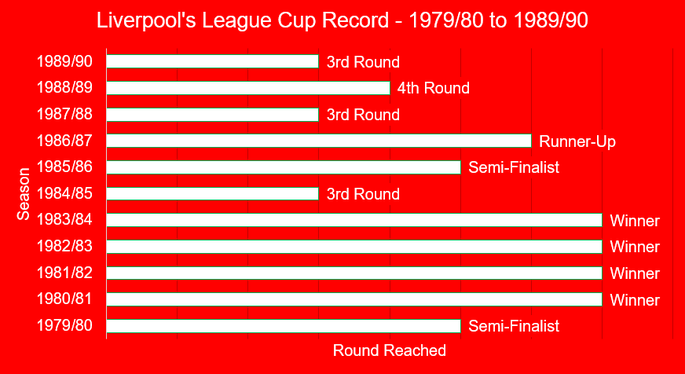
Back to the history of the trophy and whilst modern football fans will think of the likes of Manchester United, Manchester City and Chelsea as being the dominant forces in the game, the 1970s and 1980s belonged to Liverpool. Even so, the League Cup was not a competition that the Merseyside club had been able to add to their trophy cabinet, losing in the final to Nottingham Forest in 1978.
When the 1980s rolled around, however, the Reds went from being also-rans in the tournament to being a side that won it more than any other. They won it for the first time courtesy of a 2-1 win over West Ham United in 1981 and then defended it in 1982 thanks to a 3-1 win over Tottenham Hotspur. Liverpool made it a hat-trick of victories when they beat their fiercest rivals Manchester United 2-1 in 1983. Somewhat remarkably considering the club hadn’t won the competition prior to the 1980s, they made it four wins in a row when they beat Everton in 1984.
Heysel Disaster & European Ban
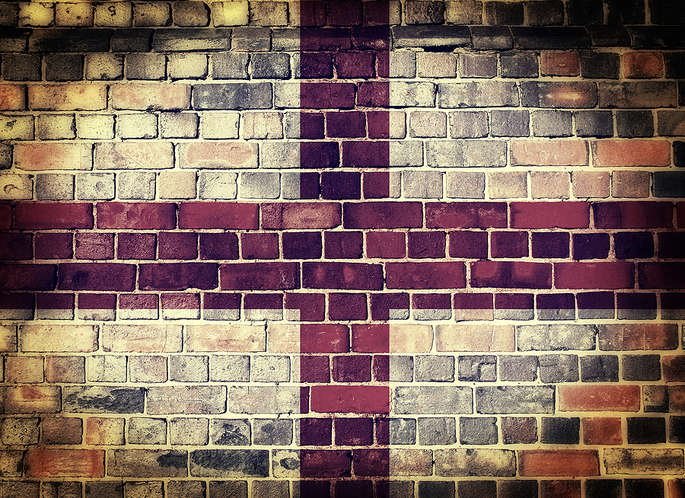
Liverpool’s domestic dominance during the 80’s meant that they were a force to be reckoned with in Europe, having won the European Cup for the first time in 1977, defended it in 1978 and then won it twice more in 1981 and 1984. In 1985’s version of the competition, therefore, they were hoping to defend their title again and win the competition for the fifth time. They made it to the final where they were due to face Juventus at Heysel Stadium, a venue that the hierarchy of both clubs had objected to the use of because it was in such a poor state. In a venue with walls that quite literally crumbled when they were touched, some Liverpool supporters found themselves in a neutral section that was supposed to be reserved for local Belgian supporters. They charged at their Juventus counterparts who backed away, only for the wall behind them to collapse. In the resulting melee thirty-nine people lost their lives.
English clubs were banned from entering European competition for an indefinite period of time. That meant that the winners of the 1985 League Cup, Norwich City, were refused entry into the UEFA Cup the following season through no fault of their own. The next four League Cups were won by Oxford United, Arsenal, Luton Town and Nottingham Forest, who also all missed out on the chance to play in the UEFA Cup as a result of the ban on English clubs taking part in any European tournaments.
| Season | Banned Club |
|---|---|
| 1989/90 | Nottingham Forest |
| 1988/89 | Luton Town |
| 1987/88 | Arsenal |
| 1986/87 | Oxford United |
| 1985/86 | Norwich City |
Even when the ban was eventually lifted, clubs still didn’t enter the UEFA Cup because of their victory in the League Cup. Both Forest in 1990 and Sheffield Wednesday in 1991 didn’t play in the UEFA Cup because of the weak UEFA coefficient as a result of the ban meaning the integration of English clubs back into Europe was gradual.
Giant Killings
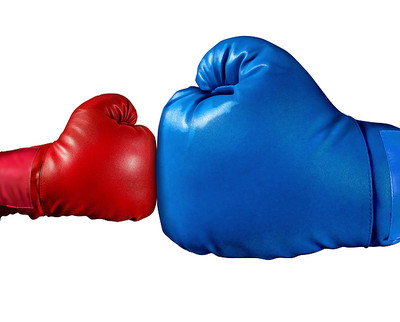 As a brief aside, it’s worth noting that there have been a number of so-called giant killings in the League Cup; primarily because of the Football League’s decision to force teams to take part in it and the desire of some sides to concentrate on other competitions, fielding weakened sides as a result. There are other reasons why a ‘giant killing’ might occur, of course. The phenomena is more widely associated with the FA Cup because of the fact that even non-league sides are allowed to play in that competition, whereas within the League Cup all sides must at least be from within the Football League. That means that the disparity in quality between the participating teams isn’t quite as big as in the FA Cup, to say nothing of the fact that the quality of host stadiums will vary wildly between the top-flight and the bottom one.
As a brief aside, it’s worth noting that there have been a number of so-called giant killings in the League Cup; primarily because of the Football League’s decision to force teams to take part in it and the desire of some sides to concentrate on other competitions, fielding weakened sides as a result. There are other reasons why a ‘giant killing’ might occur, of course. The phenomena is more widely associated with the FA Cup because of the fact that even non-league sides are allowed to play in that competition, whereas within the League Cup all sides must at least be from within the Football League. That means that the disparity in quality between the participating teams isn’t quite as big as in the FA Cup, to say nothing of the fact that the quality of host stadiums will vary wildly between the top-flight and the bottom one.
One of the first examples of a giant killing in the League Cup came about in 1967, the year that the competition first saw its final held at Wembley Stadium. First Division side West Bromwich Albion will have been hoping that they could make it there, especially after they were drawn against Third Division Queens Park Rangers and went in 2-0 up at half-time. It wasn’t to be, however, with the London club scoring three times in the second-half to knock the Midlands side out.
If that was an impressive example of a giant killing then even more noteworthy stuff was to happen almost a decade later. Chester City sat in the fourth division in the 1974-1975 season and must have been cursing their luck when they were drawn to play against the defending First Division champions Leeds United in the fourth round. It ended up being Leeds that were cursing their fortune, though, when they lost 3-0. Chester would go on to beat Newcastle United in the quarter-finals before finally succumbing to eventual winners Aston Villa at the semi-final stage.
Despite being the dominant side of both the 1990s and the Noughties, Manchester United suffered some big losses in the League Cup during those decades. The first happened in the 1995-1996 season when all rounds were played over two legs and York City beat them 4-3 on aggregate in the second round. Things were much worse in the Noughties, however, when they were defeated by Southend United, Coventry City and MK Dons in 2006-2007, 2007-2008 and 2014-2015 respectively, even though they fielded strong teams in every match.
In terms of consistency of a lower league team doing better than expected, that honour goes to Bradford City in the 2012-2013 campaign. The Bantams were in League Two at the time, yet they made it all the way to the final despite having to take on Premier League teams Wigan Athletic, Arsenal and Aston Villa along the way. The eventual winners were Swansea City, who won their first major piece of silverware thanks to the 5-0 win over Bradford, for whom the final was just one step too far.
Interesting Facts
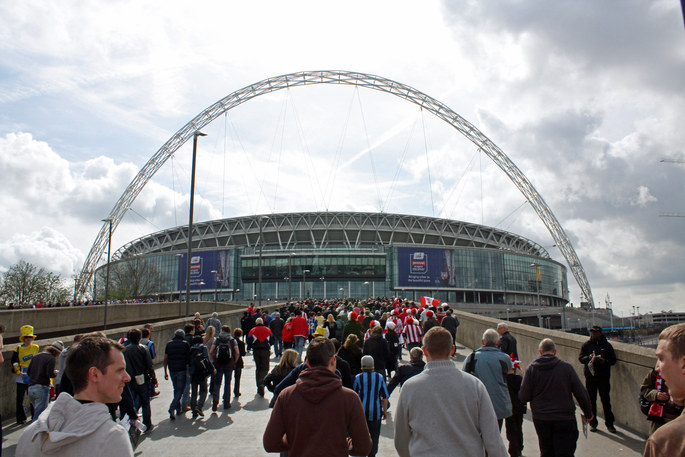
The EFL Cup’s place in the hierarchy of English football trophies might be a matter of debate, yet what can’t be argued is that it has thrown up some interesting facts over the years. No team has reached more finals than the fourteen of Liverpool Football Club, for example, who are also the record holders in terms wins with ten. Here are some other things you might find interesting:
- Since 1989, the League Cup final’s best player has been given the Alan Hardaker Trophy
- Only four players have won the Alan Hardaker Trophy more than once to date: Virgil van Dijk, Vincent Kompany, Ben Foster and John Terry
- Liverpool’s Ian Rush and Emile Heskey and Manchester City’s Fernandinho have appeared in more finals (six) than any other players
- Fernandinho has also jointly won the trophy more times (6) than any other player alongside Manchester City teamate Sergio Aguero
- Both Rush and Geoff Hurst hold the record for the most career goals in the League Cup with 49 apiece
- The 12 goals scored by Clive Allen for Tottenham in the 1986-1987 campaign remains the record for a single season
- Frankie Bunn holds the record for the most goals in a single match with an impressive six
- West Ham’s 10-0 win over Bury in 1983 and Liverpool’s victory over Fulham by the same scoreline in 1986 remain the record wins in the tournament
- When Swansea City ended League Two side Bradford City’s dream run in 2012-2013 they did so by setting a record victory in a final of 5-0
- The 14-13 score line achieved by Derby County and Carlisle United in the penalty shootout they endured in 2016 is the largest number of penalties needed to settle a League Cup tie
- Barry Venison is the youngest captain of a League Cup finalist, leading Sunderland out against Norwich aged twenty years, seven months and eight days in 1985
